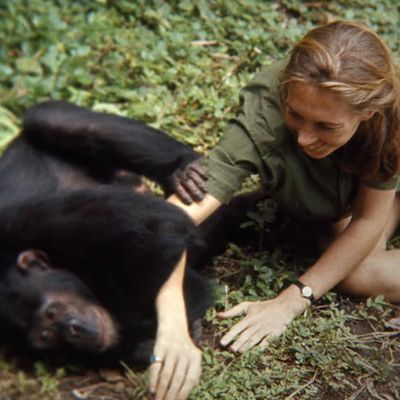
We disagree on many things, but we can all agree on Jane Goodall. Gazing on wild chimpanzees, her patience is seemingly limitless, as if there were nowhere on Earth she’d rather be than perched for hours in her cargo shorts in the wilderness of Gombe. She’s both the image and the essence of humans’ desire to understand what Goodall calls “the great mystery.”
The 26-year-old secretary chosen by Dr. Louis Leakey — who concluded that, being untrained, she’d have no university-inculcated biases — captured the public imagination (“Comely Miss Spends Her Time Eyeing Apes”) even before the early-1960s National Geographic films that people of my generation recall with pleasure. Brett Morgen’s captivating documentary Jane is an extension of that pleasure, a filling in and rounding off. I have some nits to pick with it, although one of them isn’t the time spent watching chimps pick one another’s nits. Sometimes I think we were put on Earth to pick nits.
The core of Jane is colorful footage discovered only recently of Goodall’s early years in Gombe, woven together with home movies and contemporary interviews with the now 83-year-old primatologist and U.N. messenger of peace. Goodall narrates from her books, reinforcing a philosophy that begins and perhaps even ends with living lightly on the Earth. The abundance of poisonous snakes would, for example, have kept me far from Gombe, but for Goodall, “If you walk carefully and don’t tread on it, it’s not going to hurt you.” My hunch is even a mamba would sense that hurting Jane Goodall is something one simply wouldn’t do. I’m actually not being facetious.
No one, says Goodall, had done this kind of work before, and everyone — the Brits most notoriously — subscribed to the idea that only Man was capable of rational thought. An affection for Marmite alone gives the lie to that, but very quickly Goodall saw that each chimp had his or her own personality, craved social contact, and was capable of creating and using tools. Slowly, beginning with the alpha male, the chimps learn not only that Jane will not hurt them, but is also an excellent source of bananas. Before long, they’re happily trashing her camp.
Morgen fudges the film’s chronology, showing the young Goodall trudging around spying on chimps before there was a cameraman to document it. He arrived in the form of Hugo van Lawick, an inspired wildlife photographer, chain-smoker, and baron. It turns out to be no accident that grade-school kids like me were half in love with Jane: van Lowick’s male gaze was trained as much on Goodall as the chimps. She was, admits Jane, “a subject of interest.” After leaving Gombe, van Lawick proposed to her by telegram: “Would you marry me? Stop.”
Goodall tells Morgen that a family or kids was something she’d never planned on. (Her father was unbridgeably remote, but her mother, she says, gave her the kind of self-esteem that made her certain she could hold her own against all manner of beasts.) But watching the chimps’ most powerful female, Flo, with Flo’s son, Flint, kindled something deep in her — and taught her something, too. Soon she’d strive for a relationship as primal with Grub. (“Grub” is not, alas, the name of another chimp, but the one she and Hugo chose for her son. It’s a step above Tarzan and Jane’s Boy, but the lineage is clear.) The problem is that the Gombe jungle is no place for a boy to work towards his O levels, nor are there ways for a wildlife photographer to earn a living after the supply of chimps and baboons is exhausted.
They would move on the Serengeti, but Goodall would return to Gombe to witness some horrific and tragic episodes, among them a polio epidemic, a war among chimps, and a chimp child that dies of a broken heart when separated from his mother.
There are all sorts of amazing sequences in Jane, including a Serengeti bit where a pair of lions is on the verge of administering a killing bite to some sort of bovine (I don’t know these things — caribou? buffalo? wildebeest?) when the herd makes a collective decision (you can see the thought move through them, as if by telepathy) to drive those cats the hell out of there.
Morgen gets over-fancy, though. He shifts to black and white, and cuts together shots to simulate the aforesaid war among chimps. It’s … tacky. He uses interstitial wriggly, gooey insect close-ups to remind us that life and death are everywhere in the jungle — fun to watch but … also tacky. The movie’s biggest mistake is the score, which sounded to me like someone doing an overbroad parody of Philip Glass’s churning-woo-woo Koyaanisqatsi music. It is, alas, Philip Glass. As the owner of many of his recordings (symphonies, operas, film scores), I can say with all due respect that however at one with the universe he feels, it is a different oneness with a different universe than Jane Goodall’s. Morgen gets a little Terrence Malick-y for my taste, too, as he revs up for the big finish.
Big nits but not fatal. Pick them out, move on. Goodall is a full-time activist now, bent, she says, on teaching the young to be better caretakers of the Earth “than we were.” Her modesty in including herself seemed daft, but far be it from me to lecture her on the interconnectedness of all things.


